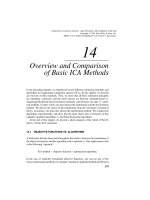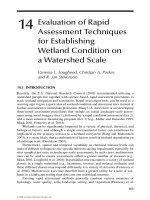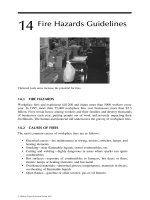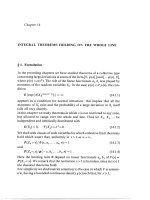OB11 chapter 14 confict and negotiation
Bạn đang xem bản rút gọn của tài liệu. Xem và tải ngay bản đầy đủ của tài liệu tại đây (464.48 KB, 37 trang )
eleventh
organizational
ior
editi
on
behav
stephen p. robbins
Chapter 14
Conflict and Negotiation
ORGANIZATIONAL BEHAVIOR
S T E P H E N P. R O B B I N S
E L E V E N T H
© 2005 Prentice Hall Inc.
All rights reserved.
E D I T I O N
WWW . PRE N HALL. C OM / ROB BI N S
PowerPoint Presentation
by Charlie Cook
OBJECTIVES
LEARNING
After studying this chapter,
you should be able to:
1. Define conflict.
2. Differentiate between the traditional, human
relations, and interactionist views of conflict.
3. Contrast task, relationship, and process
conflict.
4. Outline the conflict process.
5. Describe the five conflict-handling intentions.
6. Contrast distributive and integrative
bargaining.
© 2005 Prentice Hall Inc.
All rights reserved.
14–
3
7. Identify the five steps in the negotiating
process.
8. Describe cultural differences in negotiations.
LEARNING
O B J E C T I V E S (cont’d)
After studying this chapter,
you should be able to:
© 2005 Prentice Hall Inc.
All rights reserved.
14–4
Conflict
Conflict
Conflict Defined
– Is a process that begins when one party perceives that
another party has negatively affected, or is about to
negatively affect, something that the first party cares
about.
• Is that point in an ongoing activity when an interaction
“crosses over” to become an interparty conflict.
– Encompasses a wide range of conflicts that people
experience in organizations
• Incompatibility of goals
• Differences over interpretations of facts
• Disagreements based on behavioral expectations
© 2005 Prentice Hall Inc.
All rights reserved.
14–5
Transitions
Transitions in
in Conflict
Conflict Thought
Thought
Traditional View of Conflict
The belief that all conflict is harmful and must be
avoided.
Causes:
Causes:
•• Poor
Poorcommunication
communication
•• Lack
Lackof
ofopenness
openness
•• Failure
Failureto
torespond
respondto
to
employee
employeeneeds
needs
© 2005 Prentice Hall Inc.
All rights reserved.
14–
6
Transitions
Transitions in
in Conflict
Conflict Thought
Thought (cont’d)
(cont’d)
Human Relations View of Conflict
The belief that conflict is a natural and inevitable
outcome in any group.
Interactionist View of Conflict
The belief that conflict is not only
a positive force in a group but
that it is absolutely necessary for
a group to perform effectively.
© 2005 Prentice Hall Inc.
All rights reserved.
14–7
Functional
Functional versus
versus Dysfunctional
Dysfunctional Conflict
Conflict
Functional Conflict
Conflict that supports the goals
of the group and improves its
performance.
Dysfunctional Conflict
Conflict that hinders
group performance.
© 2005 Prentice Hall Inc.
All rights reserved.
14–8
Types
Types of
of Conflict
Conflict
Task Conflict
Conflicts over content and
goals of the work.
Relationship Conflict
Conflict based on
interpersonal relationships.
Process Conflict
Conflict over how work gets done.
© 2005 Prentice Hall Inc.
All rights reserved.
14–9
The
The Conflict
Conflict Process
Process
© 2005 Prentice Hall Inc.
All rights reserved.
14–
10
E X H I B I T 14–1
E X H I B I T 14–1
Stage
Stage I:I: Potential
Potential Opposition
Opposition or
or Incompatibility
Incompatibility
Communication
– Semantic difficulties, misunderstandings, and “noise”
Structure
–
–
–
–
–
–
Size and specialization of jobs
Jurisdictional clarity/ambiguity
Member/goal incompatibility
Leadership styles (close or participative)
Reward systems (win-lose)
Dependence/interdependence of groups
Personal Variables
– Differing individual value systems
Personality
© –2005
Prenticetypes
Hall Inc.
All rights reserved.
14–
11
Stage
Stage II:
II: Cognition
Cognition and
and Personalization
Personalization
Perceived Conflict
Awareness by one or more
parties of the existence of
conditions that create
opportunities for conflict to
arise.
Felt Conflict
Emotional involvement in a
conflict creating anxiety,
tenseness, frustration, or
hostility.
Conflict
ConflictDefinition
Definition
Negative
NegativeEmotions
Emotions
© 2005 Prentice Hall Inc.
All rights reserved.
Positive
PositiveFeelings
Feelings
14–
12
Stage
Stage III:
III: Intentions
Intentions
Intentions
Decisions to act in a given way.
Cooperativeness:
Cooperativeness:
•• Attempting
Attemptingto
tosatisfy
satisfythe
theother
otherparty’s
party’s
concerns.
concerns.
Assertiveness:
Assertiveness:
•• Attempting
Attemptingto
tosatisfy
satisfyone’s
one’sown
ownconcerns.
concerns.
© 2005 Prentice Hall Inc.
All rights reserved.
14–
13
Dimensions
Dimensions of
of Conflict-Handling
Conflict-Handling Intentions
Intentions
© 2005 Prentice Hall Inc.
All rights reserved.
Source: K. Thomas, “Conflict and Negotiation Processes in Organizations,” in M.D. Dunnette
and L.M. Hough (eds.), Handbook of Industrial and Organizational Psychology, 2nd ed., vol. 3
(Palo Alto, CA: Consulting Psychologists Press, 1992), p. 668. With permission.
14–
14
E X H I B I T 14–2
E X H I B I T 14–2
Stage
Stage III:
III: Intentions
Intentions (cont’d)
(cont’d)
Competing
A desire to satisfy one’s interests, regardless of the
impact on the other party to the conflict.
Collaborating
A situation in which the parties to a conflict each
desire to satisfy fully the concerns of all parties.
Avoiding
The desire to withdraw from or suppress a conflict.
© 2005 Prentice Hall Inc.
14–
All rights reserved.
15
Stage
Stage III:
III: Intentions
Intentions (cont’d)
(cont’d)
Accommodating
The willingness of one party in a conflict to place the
opponent’s interests above his or her own.
Compromising
A situation in which each party to a conflict is
willing to give up something.
© 2005 Prentice Hall Inc.
All rights reserved.
14–
16
Stage
Stage IV:
IV: Behavior
Behavior
Conflict Management
The use of resolution and stimulation techniques to
achieve the desired level of conflict.
© 2005 Prentice Hall Inc.
All rights reserved.
14–
17
Conflict-Intensity
Conflict-Intensity Continuum
Continuum
Source: Based on S.P. Robbins, Managing Organizational Conflict: A Nontraditional Approach
(Upper Saddle River, NJ: Prentice Hall, 1974), pp. 93–97; and F. Glasi, “The Process of Conflict
Escalation and the Roles of Third Parties,” in G.B.J. Bomers and R. Peterson (eds.), Conflict
Management and Industrial Relations (Boston: Kluwer-Nijhoff, 1982), pp. 119–40.
© 2005 Prentice Hall Inc.
All rights reserved.
14–
18
E X H I B I T 14–3
E X H I B I T 14–3
Conflict
Conflict Management
Management Techniques
Techniques
Conflict
ConflictResolution
ResolutionTechniques
Techniques
•• Problem
Problemsolving
solving
•• Superordinate
Superordinategoals
goals
•• Expansion
Expansionof
ofresources
resources
•• Avoidance
Avoidance
•• Smoothing
Smoothing
•• Compromise
Compromise
•• Authoritative
Authoritativecommand
command
•• Altering
Alteringthe
thehuman
humanvariable
variable
•©
the
• Altering
Altering
thestructural
structural
variables
2005 Prentice
Hall Inc. variables
All rights reserved.
Source: Based on S. P. Robbins,
Managing Organizational Conflict:
A Nontraditional Approach (Upper
Saddle River, NJ: Prentice Hall,
1974), pp. 59–89
14–
19
E X H I B I T 14–4
E X H I B I T 14–4
Conflict
Conflict Management
Management Techniques
Techniques
Conflict
ConflictResolution
ResolutionTechniques
Techniques
•• Communication
Communication
•• Bringing
Bringingin
inoutsiders
outsiders
•• Restructuring
Restructuringthe
theorganization
organization
•• Appointing
Appointingaadevil’s
devil’sadvocate
advocate
© 2005 Prentice Hall Inc.
All rights reserved.
Source: Based on S. P. Robbins, Managing Organizational Conflict: A Nontraditional
Approach (Upper Saddle River, NJ: Prentice Hall, 1974), pp. 59–89
14–
20
E X H I B I T 14–4 (cont’d)
E X H I B I T 14–4 (cont’d)
Stage
Stage V:
V: Outcomes
Outcomes
Functional Outcomes from Conflict
– Increased group performance
– Improved quality of decisions
– Stimulation of creativity and innovation
– Encouragement of interest and curiosity
– Provision of a medium for problem-solving
– Creation of an environment for self-evaluation and
change
Creating Functional Conflict
– Reward dissent and punish conflict avoiders.
© 2005 Prentice Hall Inc.
All rights reserved.
14–
21
Stage
Stage V:
V: Outcomes
Outcomes
Dysfunctional Outcomes from Conflict
– Development of discontent
– Reduced group effectiveness
– Retarded communication
– Reduced group cohesiveness
– Infighting among group members overcomes group
goals
© 2005 Prentice Hall Inc.
All rights reserved.
14–
22
Negotiation
Negotiation
Negotiation
A process in which two or more parties exchange
goods or services and attempt to agree on the
exchange rate for them.
BATNA
The Best Alternative To a
Negotiated Agreement; the
lowest acceptable value
(outcome) to an individual
for a negotiated agreement.
© 2005 Prentice Hall Inc.
All rights reserved.
14–
23
Bargaining
Bargaining Strategies
Strategies
Distributive Bargaining
Negotiation that seeks to divide up a fixed amount
of resources; a win-lose situation.
Integrative Bargaining
Negotiation that seeks one or more settlements that
can create a win-win solution.
© 2005 Prentice Hall Inc.
All rights reserved.
14–
24
Distributive
Distributive Versus
Versus Integrative
Integrative Bargaining
Bargaining
Bargaining
Characteristic
Distributive
Characteristic
Integrative
Characteristic
Available resources
Fixed amount of
Variable amount of
resources to be divided resources to be divided
Primary motivations
I win, you lose
Primary interests
congruent
Opposed to each other Convergent or
I win, you win
with each other
Focus of relationships
Short term
© 2005 Prentice Hall Inc.
All rights reserved.
Source: Based on R. J. Lewicki and J. A. Litterer, Negotiation (Homewood, IL: Irwin, 1985), p. 280.
Long term
14–
25
E X H I B I T 14–5
E X H I B I T 14–5









